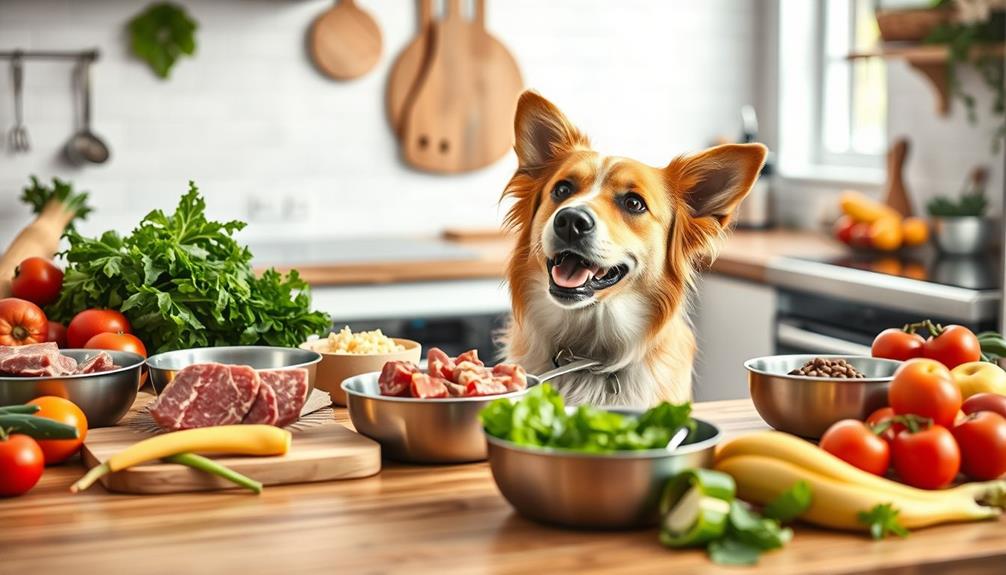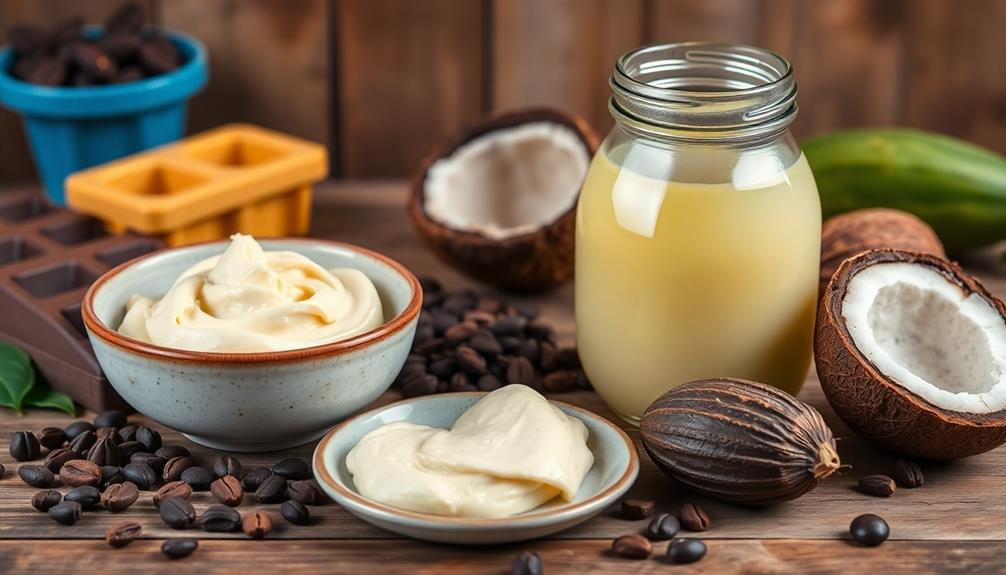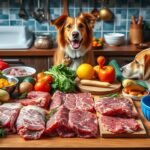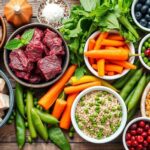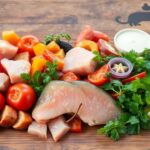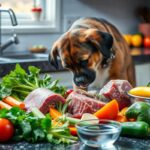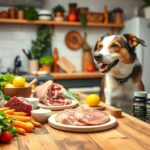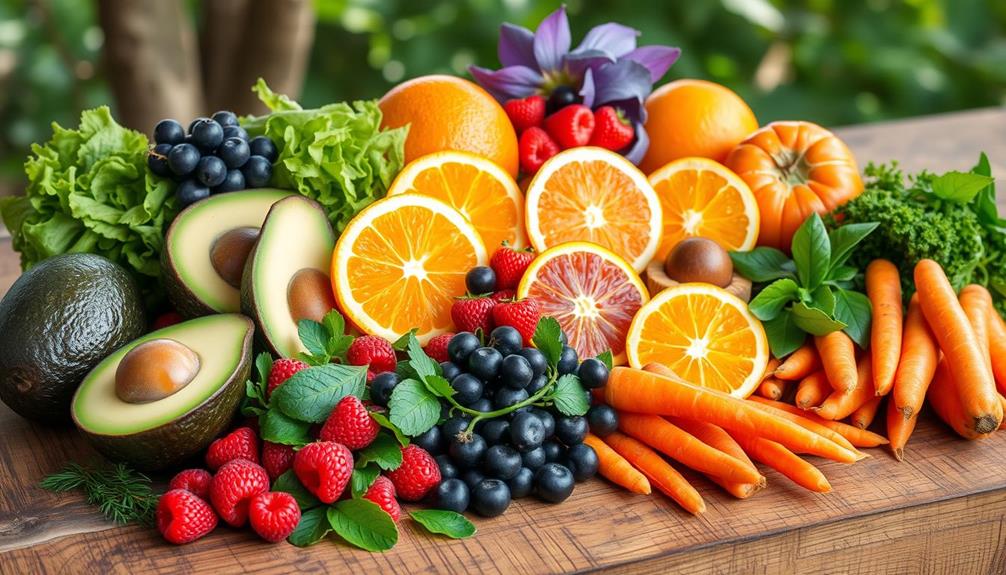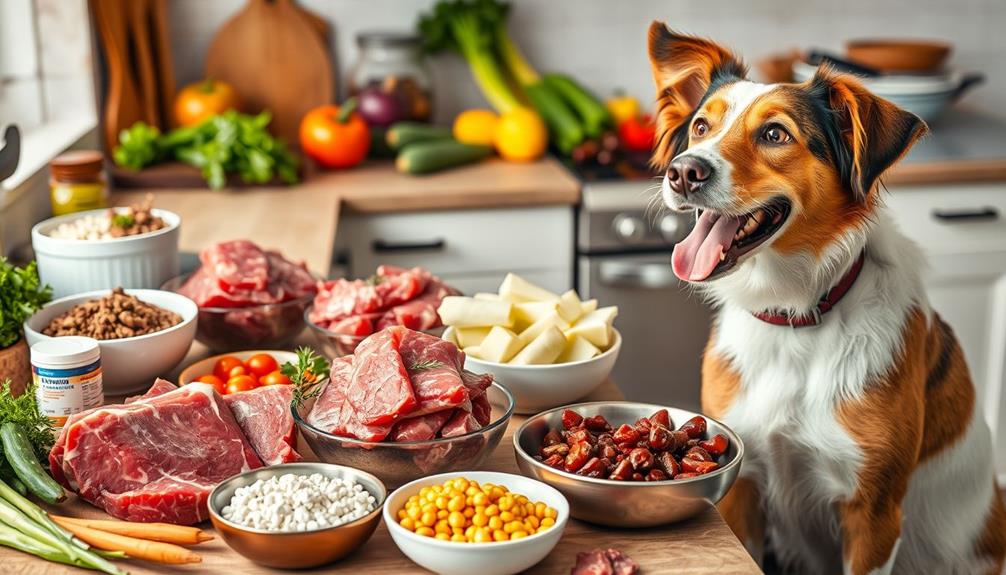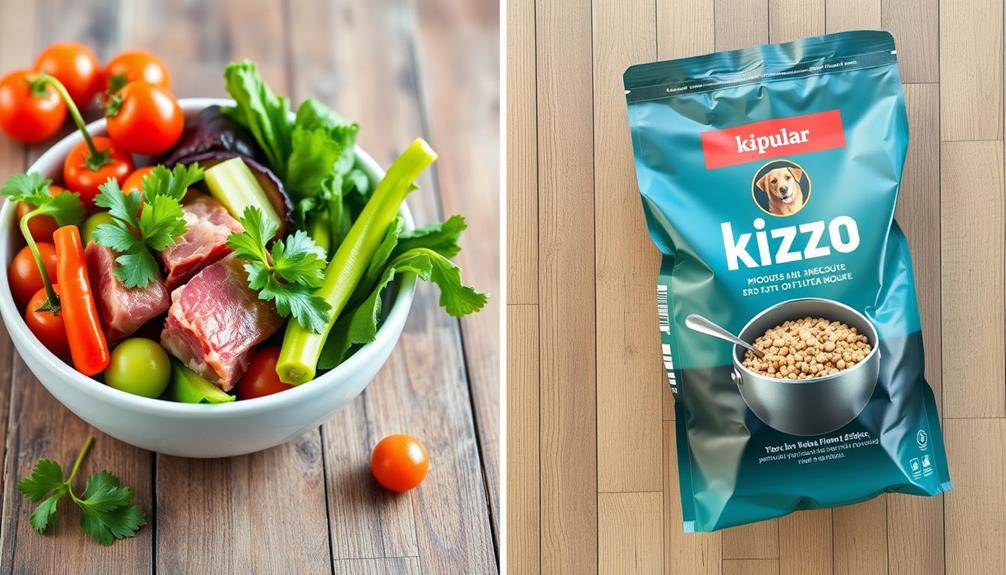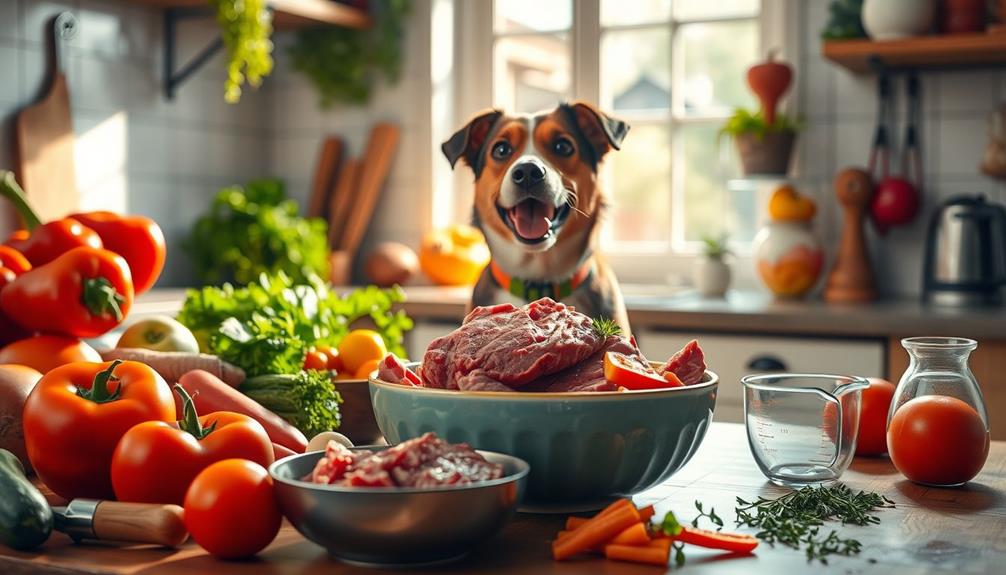Feeding your dog raw food means offering uncooked meat, bones, and organs, mimicking their natural diet. Start by mixing muscle meat, organs, and raw bones, aiming for 10-15% bone content for calcium. Shift gradually, mixing raw with their current food to avoid digestive issues. Monitor their intake based on weight—about 2-5% of their ideal body weight works well. Always practice safe handling, freezing meat to kill harmful bacteria, and wash utensils afterward. With the right approach, your dog's health can thrive on raw food. Keep exploring to discover how to enhance your dog's nutrition further.
Key Takeaways
- Transition to raw food gradually or through a straight swap, monitoring your dog's health to prevent digestive upset.
- Offer 2-5% of your dog's ideal body weight in raw food, adjusting based on age, weight, and activity levels.
- Use high-quality protein sources like chicken, beef, and fish, ensuring a balanced mix of muscle meat, organs, and raw bones.
- Follow safety precautions such as freezing meat to kill bacteria and maintaining hygiene during meal preparation.
- Buy in bulk and connect with local butchers to reduce costs while ensuring freshness and quality of raw ingredients.
Understanding Raw Dog Food
Understanding raw dog food can be a game-changer for your pet's health and nutrition. This diet primarily consists of uncooked meat, organs, and bones, designed to mirror the ancestral diets of canines, who are biologically equipped to digest raw food.
When you're feeding raw dog food, it's crucial to include quality protein sources like chicken, beef, turkey, and fish. Many pet owners also consider the financial aspects of feeding raw, as costs can vary considerably based on sourcing and preparation; therefore, it's advantageous to explore financial considerations for elderly care if you have budget constraints.
A balanced mix of muscle meat, organs, and raw bones—ideally with 10%-15% bone content for calcium—ensures your dog gets fundamental nutrients.
You might come across different raw diets, such as the BARF (Biologically Appropriate Raw Food) diet or Prey-Model Diets. Each has specific ratios and food types tailored to your dog's individual needs.
However, be cautious; avoid cooked bones, as they can splinter and pose serious health risks. Instead, raw bones will provide crucial minerals and support dental health.
Creating homemade raw diets can lead to nutritional imbalances without professional guidance, so it's wise to consult with veterinary nutritionists. They can help you design a nutritionally complete meal plan that works best for your furry friend.
Benefits of Raw Feeding
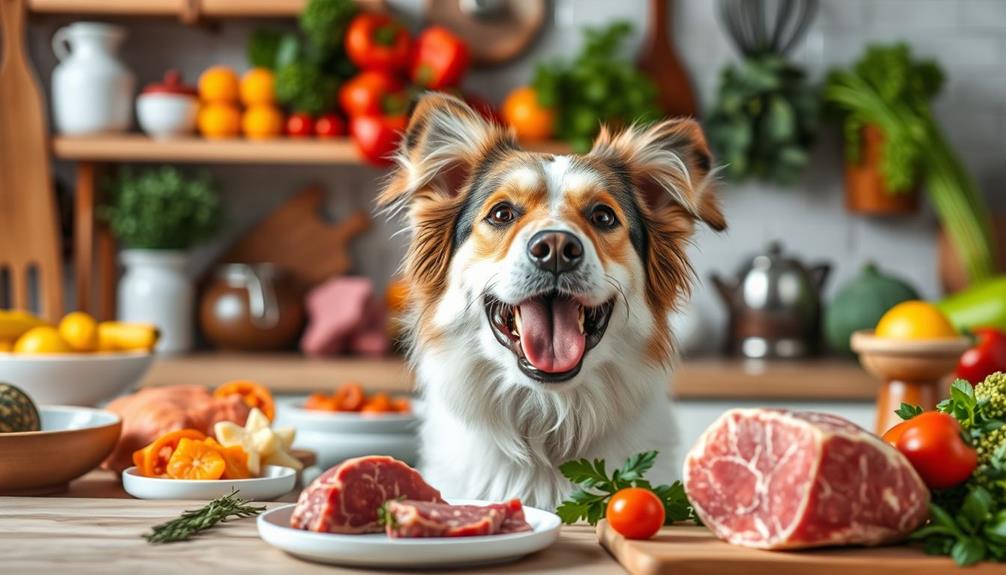
Raw feeding offers numerous advantages that can greatly enhance your dog's health and well-being. One of the key benefits of raw dog food is that it aligns with your dog's natural biology. This unprocessed nutrition mirrors the diet of their ancestors, promoting better overall health.
A raw food diet is rich in protein, essential nutrients, and antioxidants, which can strengthen your dog's immune system while avoiding harmful artificial additives found in commercial kibble. Additionally, a raw diet can provide health benefits similar to those seen in other natural diets, such as juice diets and their impact on overall wellness.
Many dog owners notice significant health benefits after changing to a raw food diet. You might see improvements in your dog's coat condition, increased energy levels, and enhanced digestive health. Fewer digestive issues and better stool quality are common reports among those who choose raw feeding.
Moreover, a balanced raw diet can improve nutrient absorption. The natural enzymes and nutrients stay intact, unlike in high-temperature cooking processes.
Additionally, raw feeding often leads to healthier weight maintenance, as these diets typically contain fewer fillers and processed ingredients. By choosing raw, you're not just feeding your dog—you're enhancing their health and longevity.
Safety and Risks

While raw feeding can greatly benefit your dog's health, it's important to be aware of the safety considerations that come with it. One of the key health risks associated with raw meat is bacterial contamination, particularly from pathogens like Salmonella and E. coli.
To minimize these risks, implement safety precautions such as freezing raw meat for at least 24 hours before feeding. This process can kill many harmful bacteria and parasites while retaining nutrients. Additionally, make sure your dog's diet includes a variety of meats and bones, as recommended in proper diet guidelines for peak health.
Always wash your hands, utensils, and surfaces thoroughly after handling raw meat to prevent cross-contamination. Remember, cooked bones can splinter and cause serious gastrointestinal injuries, so stick to raw bones when including them in your dog's diet.
It's also wise to consult with a veterinarian before changing to a raw diet. They can help guarantee your dog's nutritional needs are met and address any specific health concerns that may impact their safety on this diet.
Transitioning Methods
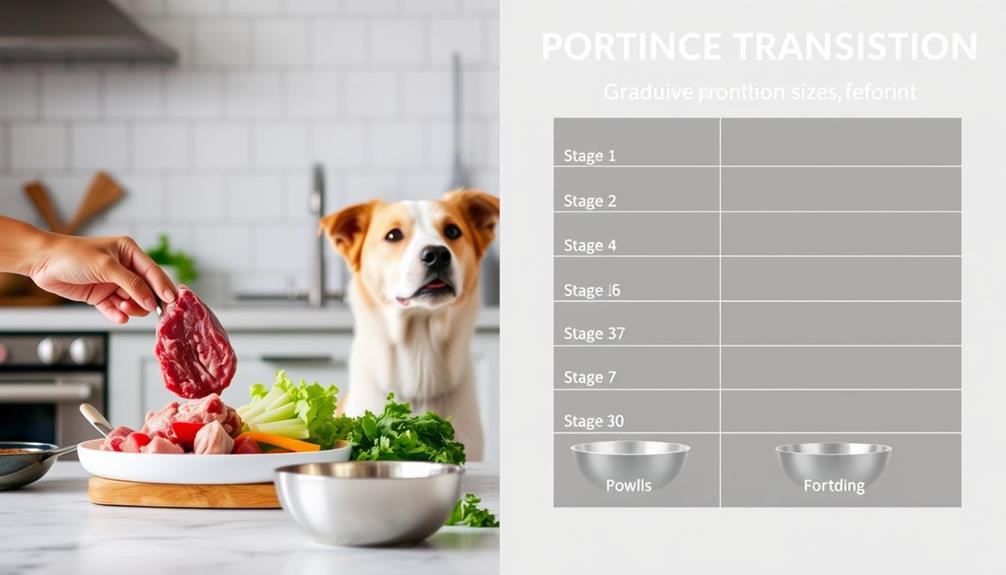
When you're ready to switch your dog to a raw food diet, you have a couple of methods to evaluate. The first is the straight swap method, where most dogs adapt easily to a sudden switch to raw meals. This approach works for about 99% of dogs, but be sure to monitor your dog's health closely during this changeover.
It's important to take into account any existing health conditions your dog may have, as some dogs might require a more gradual approach to avoid digestive upset potential side effects and interactions of cold medications.
Alternatively, you might prefer a gradual changeover. Start with 20% raw food mixed with 80% of their current diet for the first three days. Then, increase the raw percentage every few days, aiming to reach 100% raw by day 12.
This method can be gentler, especially for senior dogs or those with health issues. Throughout this process, keep an eye on your dog's behavior and health, adjusting the pace if necessary.
It's wise to consult a veterinarian before making any changes to your dog's diet. They can offer tailored advice to guarantee a safe and effective changeover.
If your dog is a bit fussy, take into account using natural dog treats as incentives to help them embrace raw food during this period.
Daily Feeding Guidelines
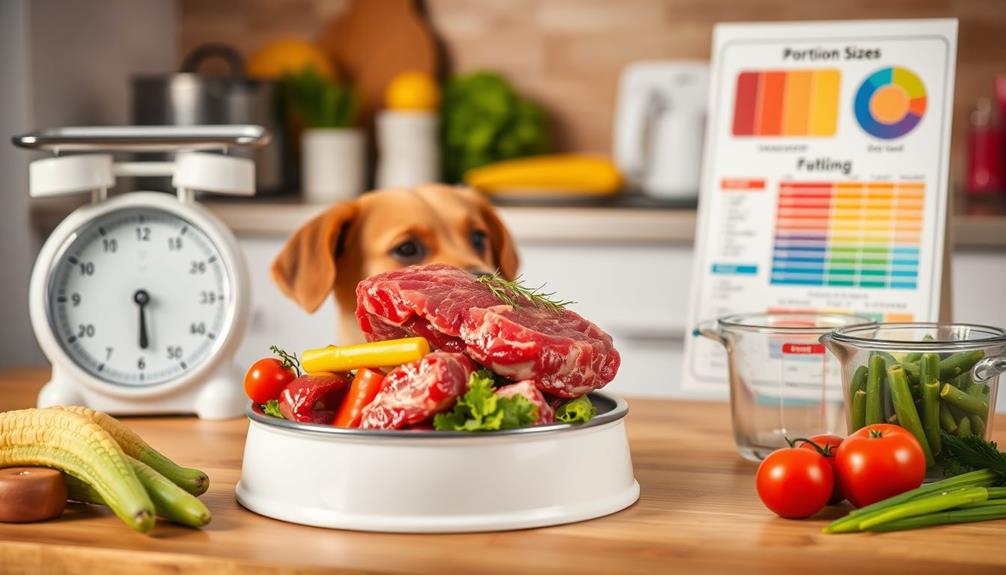
After you've successfully introduced raw food into your dog's diet, you'll want to establish a daily feeding routine that meets their specific needs. The daily feeding guidelines suggest offering 2-5% of your dog's ideal body weight in raw food. This amount can vary based on factors like age, weight, health, and activity levels.
It's also important to monitor their health and wellness to guarantee they adapt well to the new diet.
When adjusting feeding amounts, it's essential to monitor your dog's weight and overall health. A gradual shift is key; during the first 7 to 12 days, start with a 20% raw food and 80% current food ratio, moving to 100% raw by day 12.
For puppies, their feeding amounts should be higher—around 5-10% of their current weight or 2-3% of their expected adult weight, as they need extra calories for growth.
To make sure you're meeting your dog's specific dietary needs, consider using online raw food calculators or feeding guides from reputable sources. These tools will help you determine personalized feeding amounts, ensuring your dog thrives on their new raw food diet.
Preparing Raw Meals
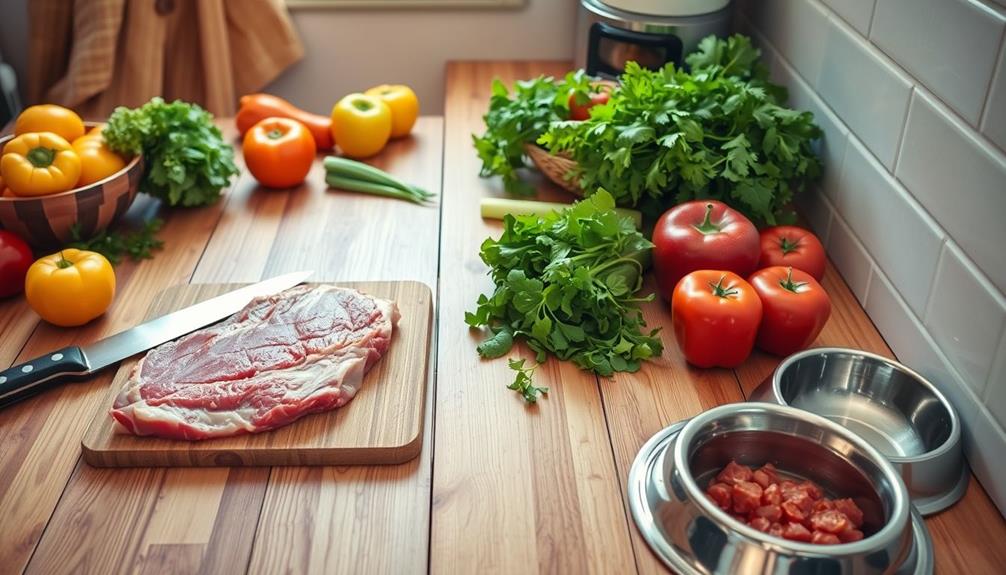
Preparing raw meals for your dog involves a few straightforward steps to guarantee the food is safe and nutritious. Here's how to get started effectively:
- Store raw dog food in the freezer for freshness. Many dog owners find that best vacuums for dust removal in 2024 help in maintaining a clean environment, which is essential when feeding raw.
- Defrost portions in the fridge for 24 hours to avoid bacterial growth.
- Always wash hands and surfaces after handling raw meat.
- Use cool water for quick defrosting if you're in a hurry.
When you're preparing raw meals, remember that defrosting is essential. Never use a microwave, as it can splinter bones and reduce the food's nutritional value. Instead, opt for the fridge method or, if you need it fast, submerge unopened tubs in cool water for about an hour.
If you're preparing smaller portions, consider partially defrosting the meat, cutting it up, and then refreezing the remainder to minimize waste.
After handling raw meat, hygiene is critical. Always wash your hands, surfaces, and utensils thoroughly to prevent cross-contamination.
Serving Suggestions
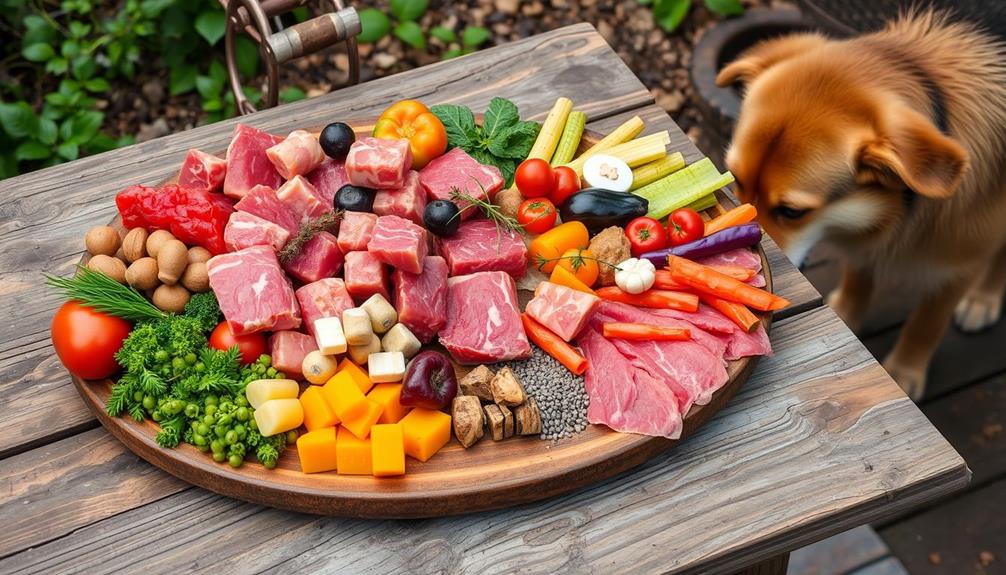
When it comes to serving your dog raw food, setting up the right environment and portion sizes is key.
A raw food diet can provide dogs with natural enzymes that aid digestion, enhancing their overall health and wellbeing. You'll want to create a calm space for mealtime and choose appropriate serving dishes that are easy to clean.
Also, keep an eye on how much food you're giving based on your dog's weight and activity level to guarantee they get the right amount for their needs, as proper portioning is essential for promoting healthier skin and coat through natural oils in raw foods.
Meal Preparation Tips
Your dog's mealtime can be a rewarding experience with the right preparation and serving techniques. Incorporating essential oils, such as lavender oil for its calming effects, can help create a soothing atmosphere during mealtime.
Here are some essential meal preparation tips to guarantee your furry friend enjoys their raw food safely and healthily:
- Store raw food in the freezer to maintain freshness.
- Defrost portions in the refrigerator for 24 hours, avoiding microwaves.
- Use glass, ceramic plates, or flat wooden boards for serving.
- Create a distraction-free environment during mealtime.
Establish a consistent feeding routine based on your dog's size and activity level, typically feeding once or twice a day. This helps your dog know what to expect and creates a sense of security.
As you introduce new raw foods, monitor your dog's response closely. Pay attention to how they react to different proteins and adjust portion sizes based on their weight and activity levels.
Aiming for 2-5% of their body weight in raw food daily will help you find the right balance. By following these meal preparation tips, you'll set the stage for a healthy, enjoyable raw feeding experience for your dog.
Portion Control Guidelines
Portion control is essential for maintaining your dog's health on a raw food diet. To start, determine the ideal daily intake based on your dog's weight. Generally, you should feed about 2-5% of their ideal body weight. Puppies need around 5-10% due to their rapid growth, while adult dogs typically require 2-3%.
It's important to monitor for any signs of emotional instability in pets as their diet changes, as this can mimic some behaviors seen in Borderline Personality Disorder (BPD).
When shifting to a raw dog food diet, begin with a mix of 20% raw food and 80% of their current diet for the first three days. Gradually increase the raw portion until you reach 100% by day 12.
Utilize online raw food calculators or consult resources from companies like Raw & Fresh to help tailor portion sizes to fit your dog's individual needs.
During this process, keep an eye on your dog's weight and health. Regular monitoring is essential, as adjusting portions based on their activity level, age, and overall health is important. If you notice weight gain or loss, modify their portions accordingly to maintain a healthy weight.
Feeding Environment Setup
Creating the right feeding environment can greatly enhance your dog's experience with a raw food diet. Establishing a consistent feeding environment setup is vital for your dog's comfort and well-being. Here are some tips to guarantee an ideal mealtime:
- Choose a quiet, calm space to minimize distractions. A serene atmosphere can help your dog feel relaxed and more willing to eat.
- Use flat wooden boards, glass, or ceramic plates for serving. Dogs often enjoy a variety of textures and flavors, which can make mealtime more engaging, much like offering healthy dog snacks to keep them satisfied.
- Clean the feeding area thoroughly before and after meals.
- Adjust feeding frequency based on your dog's size and activity level.
By designating a clean feeding area, you help create a sense of security and anticipation around mealtime.
Regularity in feeding frequency, such as two meals a day for adult dogs, can further enhance this experience.
Be certain to sanitize the area after each meal to prevent cross-contamination and maintain a healthy environment for your dog's raw food intake.
Cost-Saving Strategies
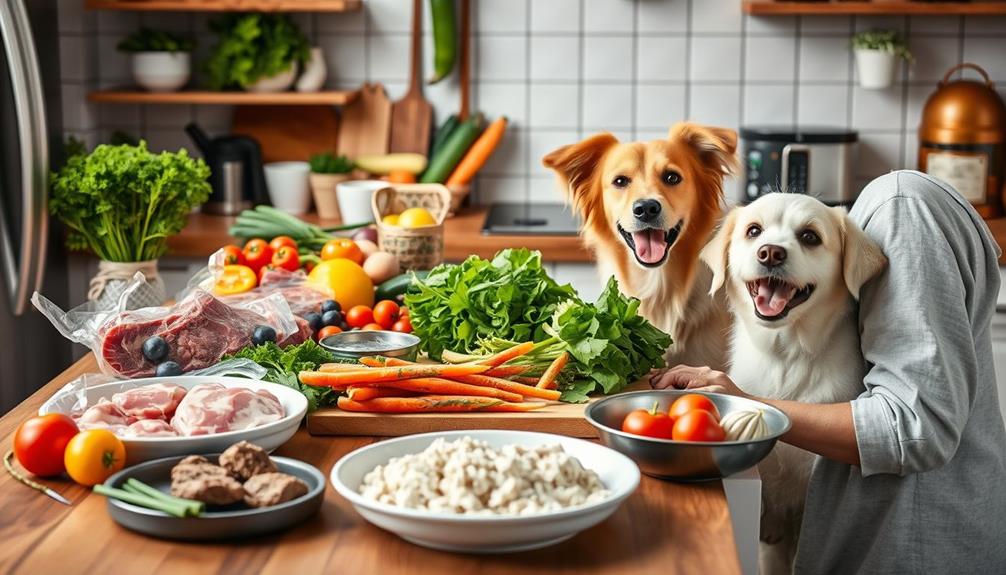
If you're looking to save money on raw dog food, buying in bulk and freezing portions can be a game changer.
Building a relationship with a local butcher can also provide you access to affordable cuts of meat and other raw ingredients.
These strategies not only cut costs but can also enhance the quality of your dog's diet.
Bulk Purchasing Benefits
Bulk purchasing raw dog food can often lead to substantial savings, making it an appealing option for dog owners looking to manage their budgets. When you buy in larger quantities, you can often enjoy discounts ranging from 10% to 30% compared to individual pack prices.
Here are some benefits of bulk purchasing:
- Extended shelf life: Freezing portions of raw meat prevents spoilage and waste.
- Cost-effective sourcing: Local butchers often offer cheaper cuts, offal, and bones for bulk purchase.
- Time-saving meal prep: Preparing homemade raw food in bulk allows for easier storage and serving.
- Community support: Joining co-ops or raw feeding groups helps you split larger orders, reducing costs further.
Local Butcher Relationships
Developing a relationship with your local butcher can be a game-changer for sourcing raw food for your dog. By connecting with your butcher, you can access high-quality cuts of meat, offal, and bones at a lower cost than commercial raw dog food options.
Many butchers offer discounts for bulk purchases, which means you can stock up on raw ingredients without breaking the bank.
Don't hesitate to ask for specific cuts or inquire about "dog food" quality meats. This approach often leads to better prices and a wider selection tailored to your dog's needs.
Establishing a regular buying schedule with your butcher not only guarantees you have consistent access to fresh ingredients but also opens the door to potential negotiations for special deals.
Additionally, many butchers are keen to discuss your local pet's dietary requirements. This can lead to valuable recommendations on sourcing appropriate raw food items that meet your dog's nutritional needs.
Community Resources

When you're considering a raw food diet for your dog, tapping into community resources can make the shift smoother and more informed.
Engaging with other dog owners and experts not only offers support but also enriches your understanding of raw feeding.
Here are some valuable resources to explore:
- Online forums and communities: Share experiences and get tips from fellow dog owners.
- Expert advice: Consult veterinary nutritionists and raw feeding specialists for tailored guidance.
- Educational resources: Access websites and eBooks that provide detailed recipes and nutritional guidelines.
- Workshops and sessions: Participate in local events at pet supply stores or butchers to learn about sourcing and preparing raw food.
Nutritional Comparisons

Many dog owners who explore community resources for raw feeding soon find themselves curious about the nutritional differences between raw diets and traditional kibble. Raw diets for dogs typically boast higher nutritional value due to fewer processed ingredients and the preservation of natural enzymes and nutrients. Kibble often contains fillers and preservatives that can dilute these benefits.
Here's a quick comparison to help you understand:
| Feature | Raw Diets | Kibble |
|---|---|---|
| Nutritional Value | Higher | Lower |
| Processing | Minimal | Highly processed |
| Digestibility | Improved | Often less digestible |
| Waste Production | Less waste | More waste |
| Cost | Can be higher initially | Generally lower upfront |
Feeding your dog a raw diet might cost more upfront, especially when using quality meats, but a well-planned raw diet can be more cost-effective than premium kibble over time. Many pet owners report benefits like improved coat health, increased energy, and overall enhanced wellness when switching to raw diets.
Frequently Asked Questions
How to Properly Raw Feed Your Dog?
To properly raw feed your dog, start by gradually introducing raw food over 7 to 10 days. Mix in proteins, veggies, and supplements while ensuring safe handling and proper defrosting to maintain nutrition and prevent contamination.
How Do You Feed Raw Dog Food Affordably?
Like a wise farmer cultivating his crops, you can feed your dog raw food affordably by buying in bulk, connecting with local butchers, and preparing meals at home for cost-effective, nutritious options that keep tails wagging.
How to Make Raw Dog Food More Appealing?
To make raw dog food more appealing, try mixing in warm bone broth, adding freeze-dried treats, or sprinkling nutritional yeast. Different textures and gradual introductions can also encourage your dog to enjoy their meals.
How Many Times a Day Should I Feed My Dog Raw Food?
You should feed your dog raw food twice a day if they're an adult. Puppies, however, need three to four meals daily. Always consider your dog's activity level and health when planning their meals.
Conclusion
So, if you're ready to commence this raw feeding adventure, just remember: your dog's new diet might cost more than your gourmet meals, but hey, who wouldn't want to be outshined by their dog at dinner? With a bit of planning and research, you can turn your pup into a raw food connoisseur. Just watch out for the occasional side-eye from the kibble crowd—they might not appreciate your dog's newfound culinary sophistication! Happy feeding!

